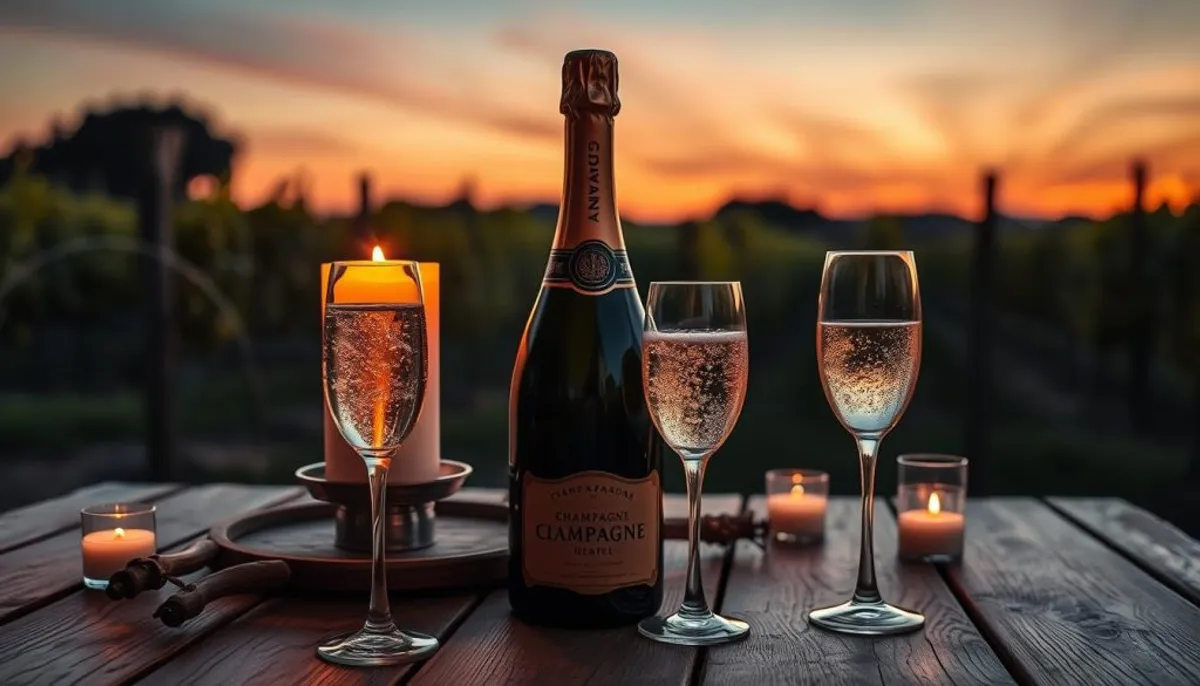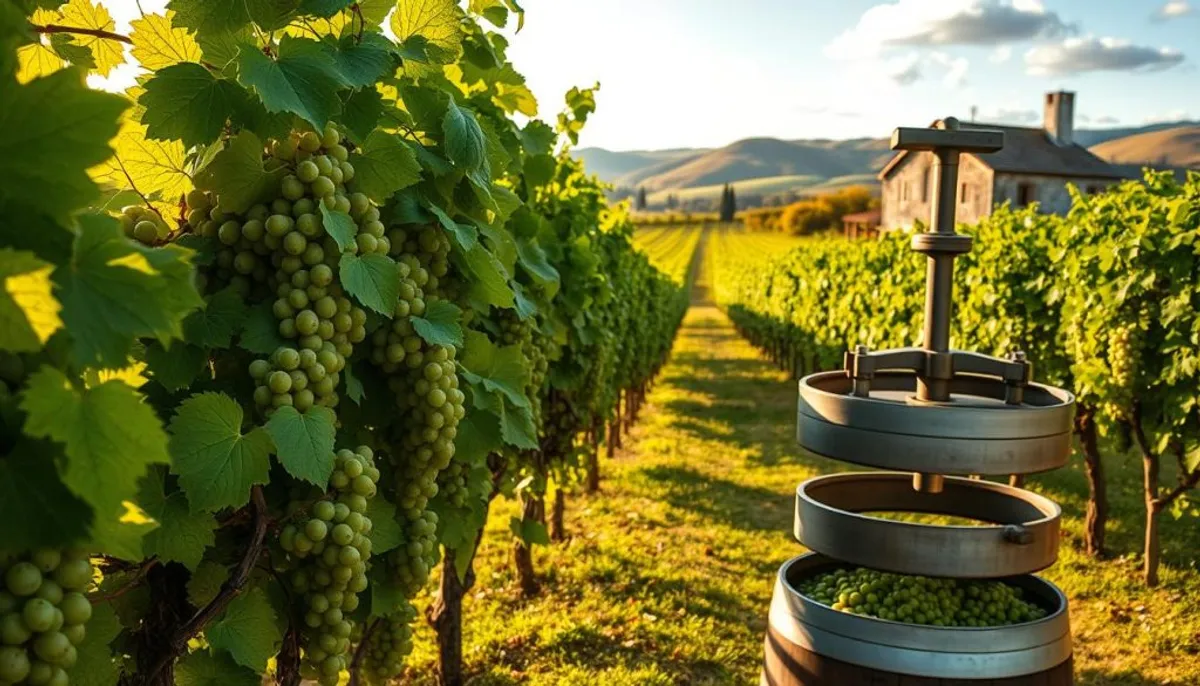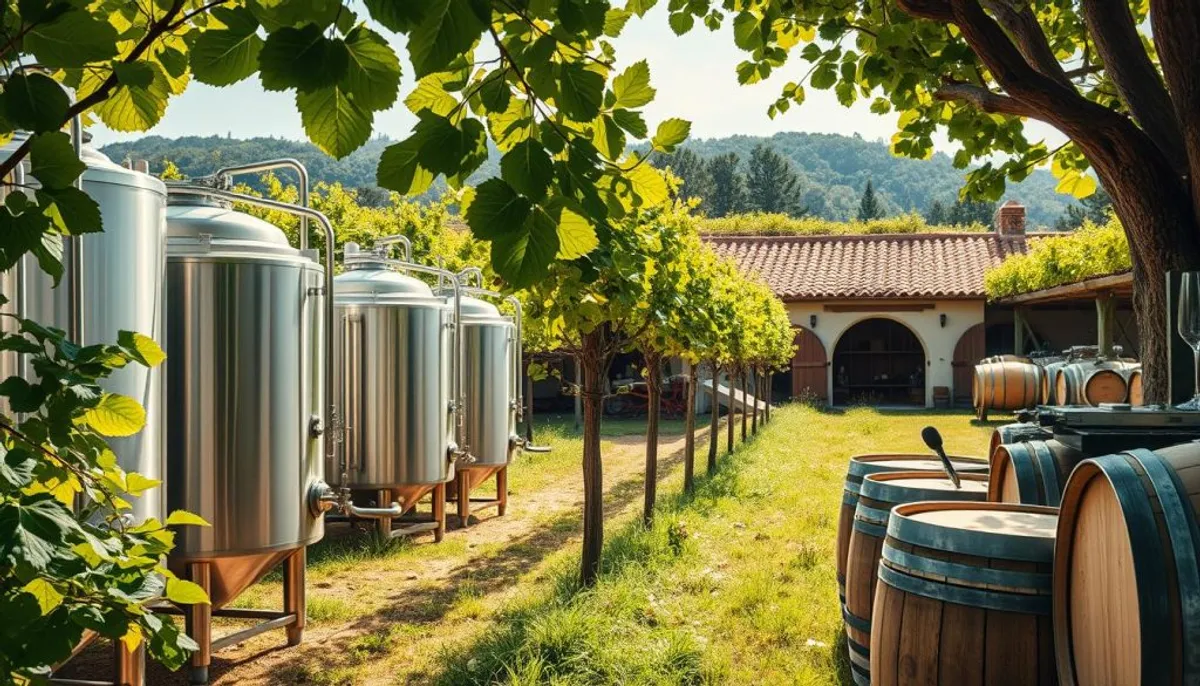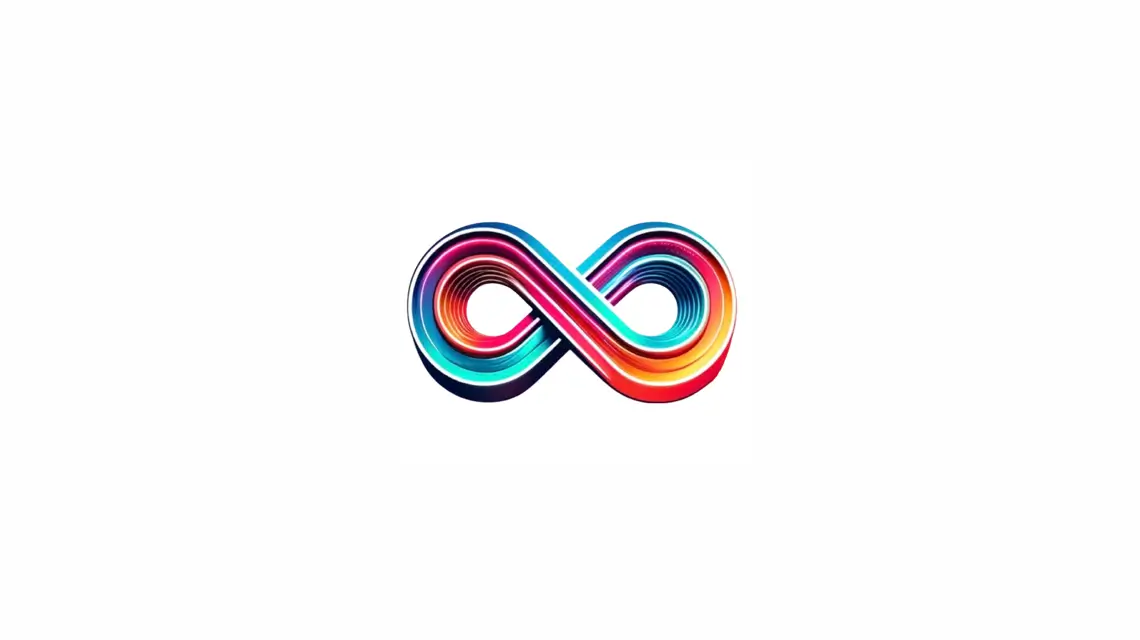In the heart of France’s Champagne region, Ernest Rapeneau shines as a paragon of artisanal winemaking. Founded in 1901 in Hautvillers, this esteemed brand has evolved into one of the 320 leading Champagne houses. As a Négociant manipulant (NM), Ernest Rapeneau creates and markets its own labels. It offers a variety of competitively priced Brut and Rosé Champagnes, capturing the quintessence of French wine heritage.

The narrative of Ernest Rapeneau is intricately woven into Champagne’s storied past. In 1927, the Champagne viticultural boundaries were established, marking the beginning of the house’s focus on Champagne trade. This dedication was solidified in 1936 with the creation of the Champagne Appellation d’Origine Contrôlée (AOC), paving the way for decades of elevated production and international acclaim.
Ernest Rapeneau remains steadfast in its pledge to quality and tradition. Its signature Brut Champagne, a blend of 45% Pinot Noir, 35% Pinot Meunier, and 20% Chardonnay, epitomizes the brand’s century-long commitment to excellence. The Brut Rosé NV, with its distinct composition of 40% Pinot Noir, 25% Chardonnay, 20% Meunier, and 15% Vin Rouge AOC Champagne, reflects the house’s innovative approach within the framework of tradition.
Key Takeaways
- Ernest Rapeneau, founded in 1901, is among 320 major Champagne houses
- The brand specializes in Brut and Rosé Champagnes
- Ernest Rapeneau is classified as a Négociant manipulant (NM)
- The house began specializing in Champagne trade in 1927
- Their Brut Champagne blends three grape varieties for a unique profile
- The Brut Rosé NV features a distinctive four-component blend
A Century-Old Legacy in Champagne Making
Ernest Rapeneau’s journey in the Champagne history began in 1901, marking the start of a remarkable wine business. The company’s roots trace back to Hautvillers, a village renowned as the cradle of Champagne.
Foundation in Hautvillers
Hautvillers, nestled in the heart of the Champagne region, provided the perfect backdrop for Ernest Rapeneau to establish his legacy. This picturesque village, steeped in viticultural tradition, became the launchpad for what would evolve into a thriving Champagne empire, including the popular épernay tours.
Early Business Development
The early years saw Ernest Rapeneau navigate the complexities of the wine business. By 1927, when viticultural boundaries were fixed, he strategically focused on Champagne trade. This decision proved pivotal, setting the stage for future growth and specialization.
Establishment of Champagne Trade
A significant milestone came in 1936 with the establishment of the AOC Champagne (Appellation d’Origine Contrôlée). This development propelled Ernest Rapeneau’s business to new heights, leading to an expanded product range and distribution network.
| Year | Event | Impact on Business |
|---|---|---|
| 1901 | Foundation in Hautvillers | Establishment of wine business |
| 1927 | Fixing of viticultural boundaries | Specialization in Champagne trade |
| 1936 | AOC Champagne established | Expanded range and distribution |
Today, Ernest Rapeneau’s legacy continues to thrive, with a diverse portfolio of up to 127 products viewed by enthusiasts worldwide. The company’s commitment to quality and tradition, rooted in the rich Champagne history of Hautvillers, remains unwavering after more than a century in the wine business.
The Ernest Rapeneau Story
Ernest Rapeneau, a pioneering figure in Champagne, founded a family business in 1901. His fervor for wine tradition ignited a legacy spanning over a century. In Hautvillers, he established his Champagne and wine venture, laying the groundwork for future generations. The region is also known for its reims wineries, which contribute significantly to the rich tapestry of Champagne production.
For five decades, Ernest devoted himself to mastering Champagne production. His relentless pursuit of quality and innovation defined the company’s ethos. In 1965, after 50 years of dedication, Ernest handed the reins to his sons, François and Bernard, entrusting them with the family’s wine heritage.
The Rapeneau Family Estates collection today encompasses a diverse portfolio. It includes three récoltant-manipulant wine estates and four maisons, each contributing to the family’s rich Champagne legacy. The acquisition of Château de Bligny in 1999 was a pivotal moment, expanding their vineyard holdings by 30 hectares in the Aube region.
| Estate | Year Acquired | Specialty |
|---|---|---|
| Château de Bligny | 1999 | Grande Reserve (50% Chardonnay, 50% Pinot Noir) |
| Champagne Vieille France | 2003 | Côte des Blancs Champagne |
| Maison Charles de Cazanove | 2003 | Historic Reims Champagne |
| P. Louis Martin | 1864 (founded) | Pinot Noir specialization |
The Ernest Rapeneau narrative is one of expansion, innovation, and steadfast commitment to Champagne excellence. From its modest beginnings to its current stature as an industry leader, the Rapeneau family upholds Ernest’s legacy while charting the future of Champagne production.
Evolution Through Generations
The Ernest Rapeneau family-owned winery has flourished across generations, each adding their distinct expertise to champagne craftsmanship. This lineage of oenology mastery has defined the winery’s essence and triumph over time.
François and Bernard’s Era
In 1944, François and Bernard Rapeneau entered the family business, introducing new viewpoints. Their tenure was pivotal, fostering growth and innovation, setting the stage for future achievements, including the exquisite veuve pelletier champagne.
Modern Leadership Under Christophe Rapeneau
Christophe Rapeneau, a graduate in oenology from the University of Reims, became the leader in 1983. His tenure brought modernization, including enhancements to fermentation rooms and production systems. Christophe’s winemaking philosophy reflects the essence of the champagne region’s grapes: Pinot Noir, Pinot Meunier, and Chardonnay.
Family Values and Tradition
The Rapeneau family’s dedication to quality is evident in their offerings. For example, their Louis Morette Brut, a mix of 56% Pinot Noir, 38% Pinot Meunier, and 6% Chardonnay, exemplifies their skill in traditional champagne blending. This commitment to craftsmanship has garnered acclaim, with over 22,000 cases of Ernest Rapeneau Brut and Rose Champagne sold through Trader Joe’s in 2021.
As the winery progresses, it harmonizes innovation with tradition, ensuring each generation enhances the legacy of the previous while upholding the family’s core values and champagne excellence.
Champagne Production Excellence
Ernest Rapeneau’s winemaking process epitomizes Champagne production excellence. The brand sources grapes from over 100 wine presses, enabling rich and varied assemblages. This diverse selection forms the foundation of their distinctive Champagnes, satisfying a wide spectrum of tastes.
Quality control stands at the forefront of Ernest Rapeneau’s Champagne production. The brand adheres strictly to the Méthode Champenoise, ensuring secondary fermentation occurs in the bottle. This time-honored technique captures the essence of Champagne, creating the signature bubbles that wine enthusiasts cherish.

The Rapeneau family’s commitment to excellence is evident in their meticulous grape selection. Their Brut Champagne, a prime example, blends 45% Pinot Noir, 35% Meunier, and 20% Chardonnay. This careful composition results in a light, refreshing Champagne with pretty aromatics and soft, round flavors.
| Champagne Type | Pinot Noir | Meunier | Chardonnay | Vin Rouge AOC |
|---|---|---|---|---|
| Brut Champagne | 45% | 35% | 20% | – |
| Brut Rosé NV | 40% | 20% | 25% | 15% |
Ernest Rapeneau’s production process involves careful selection, blending, and aging. This dedication to craftsmanship, combined with strict quality control measures, ensures each bottle meets the high standards set by the Champagne Appellation d’Origine Contrôlée. The result is a range of Champagnes that consistently delight connoisseurs and casual drinkers alike.
The Art of Grape Selection
Ernest Rapeneau’s dedication to excellence starts in the vineyards. The house meticulously chooses grapes from various terroirs across Champagne. This ensures the highest quality for their wines.
Partnership with Local Growers
Vineyard partnerships are crucial for Ernest Rapeneau’s grape sourcing strategy. By working with local growers, the house accesses diverse terroirs and grape varieties. This strategy enables them to create complex champagnes that highlight the region’s best qualities.
Vineyard Management
Rapeneau’s vineyard management focuses on three key grape varieties: Pinot Noir, Pinot Meunier, and Chardonnay. Each variety brings unique characteristics to the final blend. Pinot Noir adds body and structure, Pinot Meunier contributes fruitiness, and Chardonnay lends elegance and finesse.
Quality Control Standards
Ernest Rapeneau implements strict quality control measures in the grape selection process. From harvest to pressing, each step is monitored closely. This ensures only the finest grapes are used in Rapeneau champagnes, including their artisanal bubbles. Such a meticulous approach results in wines of exceptional quality and consistency.
| Grape Variety | Characteristics | Aging Potential |
|---|---|---|
| Chardonnay | Elegance, finesse | Develops “toasty” notes |
| Pinot Noir | Body, structure | Develops “biscuity” flavors |
| Pinot Meunier | Fruitiness, roundness | Best consumed young |
Signature Champagne Collections
Ernest Rapeneau’s signature collections exemplify the house’s mastery in crafting exquisite Champagnes. Each cuvée boasts its own unique character and appeal, showcasing the winery’s expertise.
Brut Champagne Profile
The Brut Champagne from Ernest Rapeneau is a masterful blend of 45% Pinot Noir, 35% Meunier, and 20% Chardonnay. This combination yields a crisp, refreshing Champagne, with citrus and green apple notes. Additionally, the veuve pelletier champagne offers a unique tasting experience. Priced at $10.99 for a 375ml bottle, it offers exceptional value.
Rosé Champagne Characteristics
Ernest Rapeneau’s Rosé Champagne presents a distinct profile. It is a blend of 40% Pinot Noir, 25% Chardonnay, 20% Meunier, and 15% red wine from the Champagne region. This blend results in a delicate pink hue and a flavor profile rich in red fruit notes.
Limited Edition Releases
For those in pursuit of premium options, Ernest Rapeneau presents limited edition cuvées. These exclusive releases highlight the winery’s finest grapes and most innovative blending techniques. Prices for these special bottles vary, typically ranging from $35 to $50, akin to other high-end Champagnes like Piper-Heidsieck Brut Cuvee and Moet & Chandon Brut Imperial.
| Champagne Type | Price Range | Key Characteristics |
|---|---|---|
| Brut Champagne | $10.99 (375ml) | Crisp, refreshing, notes of citrus and green apple |
| Rosé Champagne | $15 – $25 | Delicate pink hue, red fruit notes |
| Limited Edition Cuvées | $35 – $50 | Premium grapes, innovative blending techniques |
Tasting Notes and Wine Profiles
Ernest Rapeneau, a renowned family-owned Champagne house, excels in crafting wines that embody the region’s essence. Their Champagnes, with their unique flavor notes and characteristics, reflect nearly a century of winemaking mastery.
The Premier Cru Grand Reserve Brut stands out, presenting a light golden hue with fine, persistent bubbles. Its nose offers enticing aromas of crisp apple and zesty lemon, alongside subtle hints of freshly baked brioche. The palate, a harmonious blend of Chardonnay, Pinot Noir, and Pinot Meunier, results in a well-balanced and refreshing sip, making it one of the best champagne for popping.
Rapeneau’s Champagne Rosé, with its delicate salmon-pink color, immediately captures attention. Its bouquet bursts with vibrant red fruit notes, predominantly raspberry and strawberry. The wine tasting experience is smooth, creamy, and lively, with a dance of acidity on the tongue.
| Champagne | Color | Aroma | Taste |
|---|---|---|---|
| Premier Cru Grand Reserve Brut | Light golden | Apple, lemon, brioche | Balanced, refreshing |
| Champagne Rosé | Salmon-pink | Raspberry, strawberry | Smooth, creamy, lively |
Both Champagnes showcase Rapeneau’s dedication to quality and tradition. They capture the celebratory essence of Champagne, ideal for toasting special moments or enhancing everyday occasions with their exquisite flavor profiles.
Innovation in Tradition
Ernest Rapeneau seamlessly merges ancient winemaking traditions with the latest advancements. This synergy is evident in their commitment to excellence, showcased through their adoption of modern production techniques, sustainable viticulture, and uncompromising quality standards.
Modern Production Techniques
Ernest Rapeneau integrates new technologies with traditional practices, a strategy that echoes the success of winemakers like Barbara Tamburini. Since 1996, Tamburini has been perfecting her craft for estates spanning from 5 to 60 hectares. This innovative spirit is evident in their diverse product range, akin to the 135 new private label products introduced for a recent holiday season by another industry giant. Additionally, this approach reflects the rich french wine culture that emphasizes both heritage and innovation.

Sustainability Practices
At the core of Ernest Rapeneau’s ethos is sustainable viticulture. The company adheres to organic certification standards, mirroring those in regions like Chianti Rufina, where Grignano produces certified organic wine. This dedication to sustainability ensures the long-term health of their vineyards and the superior quality of their champagnes.
Quality Assurance Methods
Ernest Rapeneau upholds stringent quality standards throughout their winemaking process. Their commitment to excellence is on par with industry leaders who consistently garner accolades for their products. For example, one retailer recently received 12 awards, including 5 Best Buy titles for various products, highlighting their dedication to quality.
| Aspect | Ernest Rapeneau’s Approach | Industry Benchmark |
|---|---|---|
| Production Techniques | Blend of traditional and modern methods | Similar to Barbara Tamburini’s approach since 1996 |
| Sustainability | Focus on sustainable viticulture | Comparable to Chianti Rufina’s organic certification |
| Quality Assurance | Rigorous standards throughout production | Akin to award-winning industry leaders |
Global Distribution and Availability
Ernest Rapeneau Champagne has made significant strides in international markets. With a century-old legacy, this family-owned Champagne house has expanded its reach far beyond French borders. The brand’s commitment to quality and tradition has fueled its success in Champagne export.
Wine distribution networks have played a crucial role in bringing Ernest Rapeneau’s fine champagnes to global consumers. The brand’s presence spans across 68 importing countries, showcasing its wide appeal and accessibility. In the United States, wine enthusiasts can find Ernest Rapeneau Champagnes in popular stores like Trader Joe’s.
The company’s global reach is evident in its import statistics. Over a recent 12-month period, there were 6,787 total import shipments of Ernest Rapeneau Champagne. This impressive figure underscores the brand’s strong position in international markets.
| Distribution Statistics | Value |
|---|---|
| Total Import Shipments | 6,787 |
| Exporting Countries | 55 |
| Importing Countries | 68 |
| Number of Buyers | 722 |
| Number of Suppliers | 666 |
Ernest Rapeneau’s success in wine distribution can be attributed to its diverse product range. This includes Premier Cru Grand Reserve Brut, Champagne Rosé, and an entry-level Brut. These offerings cater to various tastes and preferences across different international markets, solidifying the brand’s global appeal.
Awards and Recognition
Ernest Rapeneau’s unwavering dedication to quality has garnered them a plethora of wine awards and accolades. Their relentless pursuit of excellence in crafting exceptional Champagnes is evident in the industry recognition and glowing consumer reviews they receive.
Industry Accolades
The Ernest Rapeneau Champagne House, alongside the renowned dom pérignon champagne house, has been honored with prestigious accolades for their outstanding products. Their 2016 Vintage Champagne, showcased at exclusive wine tasting events, has garnered significant attention from both critics and enthusiasts.
Expert Reviews
Wine experts frequently commend Ernest Rapeneau’s offerings for their quality and value. The Champagne ratings from certified sommeliers and industry professionals underscore the brand’s exceptional taste profiles and production standards.
| Champagne | Expert Rating | Tasting Notes |
|---|---|---|
| Ernest Rapeneau Brut | 91/100 | Crisp, balanced, with notes of green apple and brioche |
| Ernest Rapeneau Rosé | 89/100 | Delicate, fruity, with hints of strawberry and citrus |
| Ernest Rapeneau Vintage 2016 | 93/100 | Complex, refined, with rich notes of honey and toasted almonds |
Consumer Recognition
Ernest Rapeneau’s popularity among Champagne enthusiasts is evident in their sales figures and consumer reviews. In 2021, Trader Joe’s alone sold over 22,000 cases of Ernest Rapeneau Champagne, highlighting the brand’s broad appeal and consumer trust.
The increasing demand for Ernest Rapeneau Champagnes across various markets underscores their consistent quality and value. Wine enthusiasts value the brand’s commitment to traditional methods and innovative approaches. This dedication has fostered a loyal customer base and positive word-of-mouth recommendations.
The Future of Ernest Rapeneau
Ernest Rapeneau’s legacy, rooted in fine Champagne excellence since 1901, heralds a promising era. The brand’s century-long journey in the Champagne industry solidifies its foundation for growth and innovation. This legacy is a testament to its enduring commitment to quality and tradition.
As the Champagne industry evolves, Ernest Rapeneau remains adaptable, upholding its quality standards. Its significant market share in the luxury segment underscores its appeal and potential for expansion. This positions the brand for continued growth and market penetration.
Wine innovation is at the core of Ernest Rapeneau’s strategy. The brand’s blend of 45% Pinot Noir, 35% Pinot Meunier, and 20% Chardonnay showcases its mastery in winemaking. This expertise enables the creation of novel, captivating Champagne varieties, aligning with shifting consumer tastes.
The future of Ernest Rapeneau appears auspicious, with its NV Champagne Brut available at $9.99 at Trader Joe’s in California. This competitive pricing, coupled with its reputation for quality, paves the way for market expansion. It promises to reach both domestic and international markets, solidifying its presence globally.
| Aspect | Current | Future Potential |
|---|---|---|
| Market Presence | Significant share in luxury segment | Expansion to new markets |
| Product Range | Traditional blends | Innovative Champagne varieties |
| Pricing Strategy | Competitive ($9.99 for 375ml) | Value-based pricing for new products |
| Brand Recognition | Known for quality and tradition | Enhanced global visibility |
Ernest Rapeneau stands poised to excel in the ever-changing Champagne landscape. Its rich heritage and forward-thinking stance ensure its legacy will endure for generations to come. This outlook underscores the brand’s potential for continued success and market dominance.
Conclusion
Ernest Rapeneau’s journey in Champagne heritage spans over a century, embodying French wine excellence at its finest. Since 1901, this esteemed House has cultivated a reputation for artisanal craftsmanship. They manage 420 acres of estate vineyards with unparalleled dedication.
The Rapeneau family’s commitment to quality shines through their adherence to the Méthode Champenoise. This traditional production method involves meticulous steps from fermentation to dosage. It ensures each bottle captures the essence of their Champagne legacy.
Today, Ernest Rapeneau continues to innovate while honoring tradition. Their recent music and wine pairing events, featuring a diverse selection of wines, showcase their creative approach. With 90% of consumers favoring low dosage wines, Rapeneau’s adaptation to evolving tastes demonstrates their responsiveness to market trends.
As we raise a glass to Ernest Rapeneau, we toast not just to their past achievements, but to their future in shaping the world of Champagne. Their story is a testament to the enduring allure of French wine excellence and the art of crafting exceptional Champagne, including the exquisite laluc champagne collection.
RelatedRelated articles



